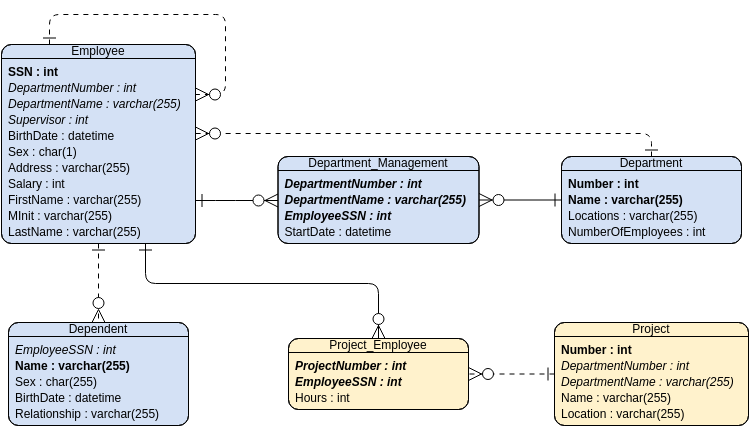Introduction
An Employee Management System (EMS) is a critical tool for organizations to manage their workforce efficiently. This system helps in tracking employee details, departmental information, project assignments, and dependencies. This guide will use an Entity-Relationship Diagram (ERD) as a case study to illustrate the design and implementation of an EMS.
Purpose of the Case Study
The purpose of this case study is to outline the functional and non-functional requirements of an Employee Management System. It provides a detailed overview of the software product, its parameters, and the design decisions needed to implement the system. The EMS is designed to streamline HR processes, improve data accuracy, and enhance organizational efficiency.

Key Concepts and Components
- Entities:
- Employee: Represents the employees of the organization.
- Department: Represents the various departments within the organization.
- Dependent: Represents the dependents of employees.
- Project: Represents the projects within the organization.
- Project_Employee: Represents the relationship between projects and employees.
- Department_Management: Represents the management of departments by employees.
- Attributes:
- Employee: SSN (PK), DepartmentNumber, DepartmentName, Supervisor, BirthDate, Sex, Address, Salary, FirstName, Minit, LastName.
- Dependent: EmployeeSSN (FK), Name, Sex, BirthDate, Relationship.
- Department: Number (PK), Name, Locations, NumberOfEmployees.
- Project: Number (PK), DepartmentNumber, DepartmentName, Name, Location.
- Project_Employee: ProjectNumber, EmployeeSSN, Hours.
- Department_Management: DepartmentNumber, DepartmentName, EmployeeSSN, StartDate.
- Relationships:
- One-to-Many: For example, one department has many employees.
- Many-to-Many: For example, employees can work on multiple projects, and each project can have multiple employees.
ERD for Employee Management System
The ERD for an Employee Management System visually represents the database tables and the relationships between them. The main entities include Employee, Department, Dependent, Project, Project_Employee, and Department_Management. The diagram helps in understanding the structure and interactions within the system.
Example ERD Components:
- Employee: SSN (PK), DepartmentNumber, DepartmentName, Supervisor, BirthDate, Sex, Address, Salary, FirstName, Minit, LastName.
- Dependent: EmployeeSSN (FK), Name, Sex, BirthDate, Relationship.
- Department: Number (PK), Name, Locations, NumberOfEmployees.
- Project: Number (PK), DepartmentNumber, DepartmentName, Name, Location.
- Project_Employee: ProjectNumber, EmployeeSSN, Hours.
- Department_Management: DepartmentNumber, DepartmentName, EmployeeSSN, StartDate.
Functional Requirements
- Employee Management:
- Add, update, and delete employee records.
- View employee details and dependencies.
- Department Management:
- Add, update, and delete department information.
- Assign employees to departments.
- Project Management:
- Add, update, and delete project information.
- Assign employees to projects and track hours worked.
- Dependent Management:
- Add, update, and delete dependent records.
- View dependent details linked to employees.
- Department Management:
- Assign managers to departments.
- Track the start date of department management.
Non-Functional Requirements
- Performance:
- The system should handle a large number of concurrent users efficiently.
- Query execution should be optimized for quick response times.
- Security:
- Implement role-based access control to ensure data security.
- Encrypt sensitive employee and dependent information.
- Scalability:
- The system should be scalable to accommodate the growing number of employees and projects.
- Support for distributed database systems to handle increased load.
Implementation Details
- Database Design:
- Normalize the database to reduce redundancy and ensure data integrity.
- Implement indexing on tables for fast query execution.
- Technology Stack:
- Use a relational database management system (RDBMS) like MySQL or PostgreSQL.
- Develop the application using a web framework such as Django or Spring Boot.
- User Interface:
- Design an intuitive and user-friendly interface for easy navigation.
- Provide dashboards for employees, managers, and HR administrators to access relevant information.
Conclusion
The Employee Management System, as illustrated by the ERD, provides a comprehensive solution for managing the workforce of an organization. By following the outlined functional and non-functional requirements, the system can be implemented to streamline HR processes, improve data accuracy, and enhance organizational efficiency.
For more detailed information and examples, refer to the ER Diagram for Employee Management System and the Employee Management System ER Diagram.

